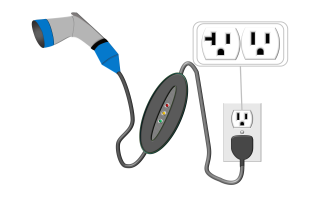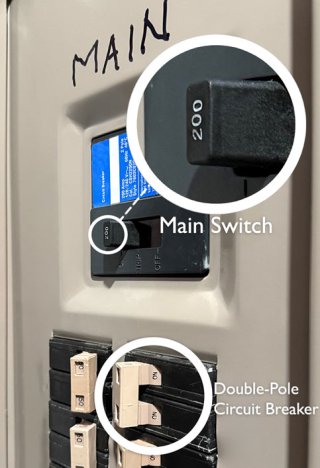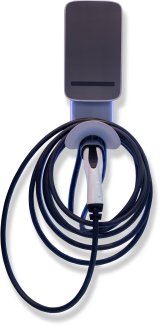Getting Started with Home EV Charging
Charging an EV is different from filling a gas tank. Most charging happens where you already park, like at home. Plugging in takes less than a minute and while it can take hours to fully charge, it happens while you are asleep and can allow you to skip visiting a fuel pump once or twice a week. Charging at home is typically the most time- and cost-effective method, plus you to start each day with a fully charged vehicle. You can find EV chargers for sale online and in many retail stores, but here’s what to consider:
🔌What Size Charger Do I Need?
Pro Tip: Use our Home EV Charger Calculator to determine the ideal charging setup for your specific needs and vehicle. You might have what you need to charge an EV at home today.
Choose the Power Level for Your Vehicle
Choosing the right charging level depends on:
- your driving habits
- your home
- your budget
Chargers are usually labeled in terms of Amps and Volts. The higher the numbers, the faster you can charge. There are two primary levels of home chargers:
|
Level 1 Chargers (120 Volts) 
|
Level 2 Chargers (240 Volts) 
|
|---|---|
|
|
| Existing outlets for these are commonly found outside homes, inside garages, and at many condos, apartments, and workplaces. If this meets your range requirements, you can save time and money and start charging right away. | This usually requires professional installation but can recharge more miles overnight if you drive longer distances regularly. |
Select the Connector for Your Vehicle
There are two major connector types. Once you pick your vehicle, you will want to choose a charger with the correct connector. No need to worry, however, as adapters exist to allow chargers with one connector type to charge vehicles with another.
| J1772 | J3400/NACS |
|---|---|

|

|
| Almost all vehicles use a common connector for both Level 1 and 2 charging, called J1772. |
Originally used only by Tesla vehicles. Starting with model year 2025, some newer vehicles began using this connector as well. |
Choose the Charger Features You Want
Chargers range from what are essentially simple cables with safety features to more advanced units with many capabilities. The simplest models function much like your phone charger— just plug in and power up your vehicle. More advanced models can provide optional features such as:
- Adjusting the maximum Amps it will deliver
- Sharing power intelligently with other chargers or household appliances
- Tracking and analyzing your energy usage
- Scheduling charging to take advantage of lower off-peak electricity rates, where available
- Preventing access to unauthorized users
For options beyond the charging cable that comes with many EVs, PlugStar maintains a comprehensive directory of Level 2 chargers.
Safety Considerations for Chargers
| Choose a Laboratory-Safety Certified Charger | Not all EV chargers for sale are safety certified. Choosing an ENERGY STAR certified charger ensures it has been approved to meet safety standards by a nationally recognized testing laboratory (e.g., UL or ETL). |
|---|---|
| Select a Reasonable Cable Length | Make sure the charger’s cable is long enough to reach your vehicle comfortably and safely where you park it. |
| Ensure Your Charger Is Weatherproof | If you are installing a charger outside your home, search for a model that is rated to withstand rain and the elements. |
| Hardwiring Your Charger is Safer | For chargers rated at 48-Amps or higher, they are usually required to be hardwired instead of plugging them into an outlet. While using an outlet allows you more flexibility to swap chargers without an electrician, hardwiring them provides better safety. |
Hire an Electrician for Installing a New Charger

If you are reading this, you probably need to hire an electrician, unless you already have something like a NEMA 14-50 outlet that you're confident was properly installed. Installing a new circuit for EV charging requires modifications to your electrical system—something best left to a professional.
What to Expect from an Electrician
- Perform a load calculation: An electrician can determine if your existing electrical panel can handle an EV charger, or if you might need upgrades.
- Obtain permits and inspections: Many areas require obtaining permits and safety inspections for residential electrical work, including EV charger installations.
- Ensure chargers are installed safely: In addition to the safety considerations above, be sure your circuit breaker is sized at least 125% of the charger it is attached to. As an example, a 40-amp Level 2 charger would require a dedicated 50-amp electrical circuit.†
How Much Power Does My Home Have?

Understand Your Home's Electrical Capacity
If your home has at least 200-Amps and two empty slots for a double-pole circuit breaker in your panel, you likely have capacity for a Level 2 charger. Even 100-Amp service is often sufficient, depending on how much electricity your other appliances use.


Although older homes tend to have less excess power available, there are often alternatives beyond simply upgrading your electrical service capacity:
- Use a lower-powered charger: A 16-Amp Level 2 charger might perfectly suit your needs if your electrical panel is tight on capacity. Try our Home EV Charger Calculator to see how much power you need based on your vehicle and driving habits.
- Ask your electrician about load management or circuit-sharing systems: These technologies can balance electricity use between your EV charger and other appliances, preventing overloads and maximizing your home's existing electrical capacity.
- Consider potential future electrical needs if you decide to upgrade capacity: Plan for scenarios like charging multiple EVs or transitioning from gas to electric appliances (such as heat pumps) that could increase your home's electrical power requirements.
Budget for Installation Costs
Installing a Level 2 charger involves both equipment and labor costs. Installation costs can increase based on higher amperage chargers, longer distances from the electrical panel, tricky installation locations, and whether or not electrical upgrades are needed:

$400–$1,000 depending on features

$300–$2,000 depending on your home’s setup
Check for Incentives
There are incentives and tax credits at the Federal, state, and local levels for upgrading your home's electrical capacity and installing EV chargers. Electrical utilities often have rebates as well. Visit ENERGY STAR Incentives or Rewiring America to see what’s available in your area.
Common Questions
What if I don’t have driveway or garage access?
If your EV is parked on the street, this can be a challenge. You may still have options beyond public chargers:
- Check with your city to see if they are willing to install curbside chargers for you to use while parked on the street. Some cities have programs where residents can request curbside charger installation (such as Boston; Seattle; Portland; and Washington, DC).
- Chargers with longer cables can also sometimes be a solution but be sure to check your local rules and regulations for how to keep your charging cable from being a tripping hazard to others.
What if I rent my home or live in an apartment or condo?
If you live in a rental or a shared building without the ability to plug in, Right-to-Charge laws in many states may give you the legal right to install a charger if you have a designated parking space. Speak with your building management about EV charging options and check local regulations. This applies to renters of single-family homes and townhouses as well.
What if I am building a new home and think I might want an EV in the future?
If you aren’t ready for an EV yet but think you might eventually drive one, you can lower your total costs by making your home EV-ready (pdf) (716 KB, January 2024) during construction, even if you aren’t adding a charger yet. Pre-wiring the home while it is being built and installing a National Electrical Manufacturers Association (NEMA) 14-50 outlet to use with an eventual charger is much cheaper than adding the capability after the house has been constructed. Another option is to plan for unused electrical panel capacity and install a conduit (raceway) in the wall to accommodate running an electrical line in the future.
† In accordance with National Electrical Code (NEC) Article 625.41.

